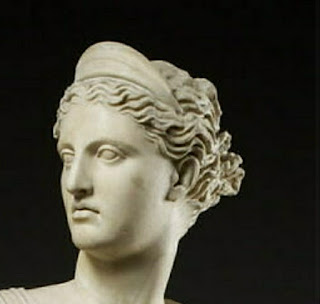A VISIT TO LOUVRE MUSEUM, PARIS: Diana of Versailles.( In room No 348, Sully Wing, Musee du Louvre )
As one enters room no 358 of the Sully Wing in the Louvre Museum, Paris, one is confronted with some amazing sculptures. Done in marble, most of these sculptures are either from ancient Greece or ancient Rome. One prominent sculpture on display in this room is known as Diana of Versailles. It is a marble statue gifted by Pope Paul IV to the King of France in 1556. It was discovered in Italy. Some sources suggest its origin in the Temple of Diana (Nemi), an ancient sanctuary while some suggest its origin in Hadrian's Villa at Tibur.
In the sculpture under discussion, the Greek goddess Artemis (Roman Diana) draws an arrow from her quiver and grasps a stag by the horns. She wears a knee-length maiden's dress, sandals and a tiara crown. Known as the Diana of Versailles in France as it used to adorn the 'Hall of Mirrors ' at the Château de Versailles, it is a slightly over-life-size statue of the Greek goddess. It was done in Rome sometime 1st or 2nd century AD. The original bronze statue in Greece, attributed to the Greek sculptor Leochares was lost. The original bronze statue is believed to have been done in c. 325 BC. There is a striking similarity between the Diana of Versailles and the famous Apollo Belvedere in the Vatican and believed to have been done by Leochares. It is believed that in ancient Greek society, tall women were associated with power, dignity and poise.
Leochares (4th Century BCE) was one of the prominent sculptors of Athenian Hellenistic Greece during the 4th century BCE. Leochares's main claim to fame was that he worked on the Mausoleum of Halicarnassus with Skopas - one of the greatest sculptors of 'Classical Antiquity'.
The statue is also known as Diana à la Biche, Diane Chasseresse ("Diana Huntress"), Artemis of the Chase, and Artemis with the Hind.
The statue was given by Pope Paul IV to Henry II of France in 1556 and intended for the King's mistress, Diane de Poitiers.
In 1602, Henri IV removed it to the Palais du Louvre, where it was installed in a gallery specially designed for it. In 1696, it was installed in the Grande Galerie (Hall of Mirrors) of Versailles Palace by Louis XIV. As one of France's greatest treasures, the statue returned to the Louvre after the French Revolution. In France, this statue acquired a reputation equivalent to the masterpieces in the Belvedere or the Villa Borghese.
Artemis was one of the most widely venerated of the Ancient Greek deities. Her Roman equivalent is Diana. Some scholars believe that the name, and indeed the goddess herself, was originally pre-Greek. Homer refers to her as Artemis Agrotera, Potnia Theron: "Artemis of the wildland, Mistress of Animals". The Arcadians believed she was the daughter of Demeter.
In the classical period of Greek mythology, Artemis (Ancient Greek) was often described as the daughter of Zeus and Leto, and the twin sister of Apollo. She was the Hellenic goddess of the hunt, wild animals, wilderness, childbirth, virginity and protector of young girls, bringing and relieving disease in women; she often was depicted as a huntress carrying a bow and arrows. The deer and the cypress were sacred to her. In later Hellenistic times, she even assumed the ancient role of Eileithyia in aiding childbirth.
This goddess of chastity could punish the misdeeds of men by shooting arrows. In the sculpture, Artemis is shown in action, with her tunic (the chiton) tucked up to her knees to make it easier to pursue her quarry. A cape (the himation) passing over her left shoulder, clings closely to her form.
( Avtar Mota )
CHINAR SHADE by Autarmota is licensed under a Creative Commons Attribution-Noncommercial-No Derivative Works 2.5 India License.
Based on a work at http:\\autarmota.blogspot.com\.






No comments:
Post a Comment
Note: Only a member of this blog may post a comment.